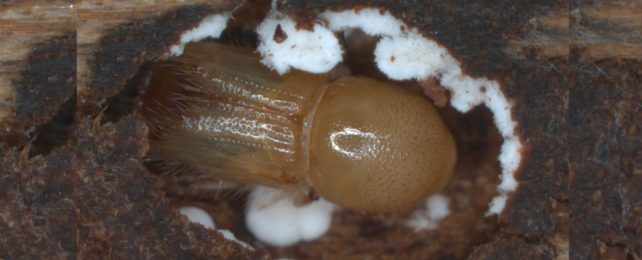Millions of conifers have been destroyed across Europe due to infestations of the Eurasian spruce bark beetle (Ips typographus), and fungi may be helping the tree-killing critters by manipulating the tree's natural defenses.
According to a new study, the tiny beetles can sniff out aromatic compounds produced by their symbiotic partners – fungi – breaking down tree resin, making it easier for the beetles to find suitable trees to eat and have babies in.
A better understanding of how these compounds affect bark beetle attacks could help protect Europe's conifers, the study authors say, and this is important as climate change makes Europe's forests more vulnerable to insect invasions.
The approximately 5 millimeters (0.2 inches) long I. typographus can kill mature trees relatively quickly, which is attributed to the fact they attack in large numbers to overwhelm the tree's defenses and how they introduce fungal symbionts that help the beetles invade and settle in the tree.
Many interactions between insects and the plants that host them have been linked to fragrant compounds. Trees make an elaborate mix of compounds to repel, entrap, or poison the insects that eat them and the friendly fungi that live with the insects in an ectosymbiotic relationship.
We know that the beetles use pheromones to attract new recruits for mass attacks; compounds produced by the 'conquered' tree also herd in other beetles. However, the role of pheromones in keeping the fungal symbiosis going is not well understood.
The ability of bark beetles to overcome the powerful defense system of conifers has led some scientists to wonder if fungi might be helping since the fungi produce their own potent mix of volatile chemicals. And beetles preferentially target trees infected with symbiotic fungi.
The authors showed in previous research that I. typographus could identify its fungal symbionts of the genera Grosmannia, Endoconidiophora, and Ophiostoma by their chemical compounds.
Now they have shown that Grosmannia penicillata and other fungal symbionts metabolize spruce resin compounds from the Norway spruce (Picea abies), which is the beetle's host tree, altering the aroma into an attractive blend of oxygenated derivatives.
"We had already been able to show that bark beetles are attracted to their fungal associates when these are cultured on standard fungal growth medium," says lead author Dineshkumar Kandasamy, a biochemist at Lund University in Sweden.
"Now we wanted to know what would happen if we grew fungi on a more natural medium with spruce bark powder added. Would beetles be attracted to fungi now?"
The team of researchers from Europe and South Africa performed a series of tests in the lab with bark beetles and samples of bark from Norway spruce trees to find out what chemical signals the beetles use to find trees infected with the fungus.
They found that G. penicillata fungus breaks down chemicals in the bark resin, known as monoterpenes, into new compounds and that 12 days after fungal infection, these compounds made up most of the chemicals that the bark samples gave off.
Specific pheromones in the bark attracted the beetles, and female beetles, in particular, were more interested in the pheromones on the spruce bark when symbiotic fungi were present.
Researchers also found that I. typographus have dedicated olfactory neurons sensitive to these oxygenated compounds. Another type of fungus called Trichoderma sp., which is harmful to bark beetles, was also tested, and it produced oxygenated metabolites too, but I. typographus wasn't interested in them.
Kandasamy and colleagues were surprised to find that when fungal symbionts grew on the spruce bark, beetles were drawn to the bark and made tunnels in it.
The results suggest that bark beetles can smell mixtures of compounds produced by fungi and follow the scent depending on whether those fungi are their symbiotic partners or a danger to them.
The oxygenated metabolites may help beetles determine if a fungus is present, how well the host tree protects itself, or if the fungi are overwhelming it, and locate potential feeding and breeding sites.
"The ability of the fungus to metabolize resin components that are originally produced by the tree as a defense could indicate which fungi are virulent and could serve as good partners for the beetle," says Jonathan Gershenzon, a biochemist from the Max Planck Institute for Chemical Ecology.
But while the fungus's pheromones may be devastating to trees, it could be the secret ingredient to better management of beetle invasions.
Currently, pest control methods only use beetle pheromones to attract victims, but they aren't very effective. Adding fungal chemicals to the mix could be the key to getting more beetles into the pheromone traps and saving more trees.
The study has been published in PLOS Biology.
